Canon Rangefinder 35 mm Lenses
A Description of Canon Rangefinder 35 mm Lenses produced 1950-1975
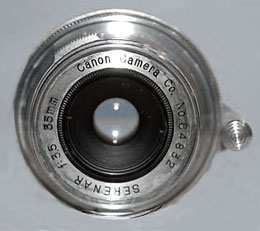
the Serenar 35mm f3.5 lens of 1950
The First Serenar 35mm f3.5 of 1950
In March 1950, Canon released its first wide-angle lens, the Serenar 35mm f3.5. Peter Kitchingman states that "this lens was a close copy of the four element 35mm Leitz Elmar triplet." 2 This lens design was of 4 elements in 3 groups.

This lens was delivered in a very nice leather case with the lens name stamped on the top. Inside, as well as the lens and lens cap, was a Canon 35mm accessory finder with rear adjusting parallax ring in a fitted pocket in the lid of the leather case. A 36mm screw-in adapter ring could be used to attach Series VI accessories.
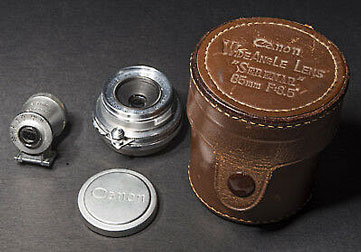
the Serenar 35mm f3.5 lens of 1950 with Canon accessory finder in a well-finished fitted leather case
Canon also offered a slide-on Series VI lens hood which could be used either with the Serenar 35mm f3.5 lens or the Serenar 50mmm f1.9 lens. It also was sold in an attractive leather case.
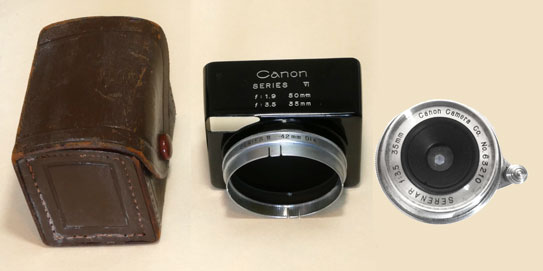
the Canon lens hood, with case, which could be used on both the 50mm f1.9 and the 35mm f3.5 of 1950
This Serenar 35mm f3.5 lens was on the market for slightly over one year until it was succeed with a new, slightly faster Serenar 35mm f3.2 in May 1951. During its one year, the Serenar 35mm f3.5 sold 5,856 lenses, a substantial number for that era.
The Serenar - Canon 35mm f3.2
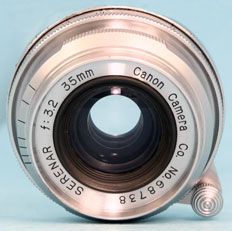
Serenar 35mm f3.2 of 1951
Canon released a new Serenar 35mm f3.2 in May 1951. It had 6 elements in two groups of 3.
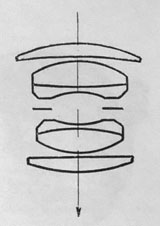
Then, in 1952, Canon began to multi-coat this lens. Also in December 1952 conforming with its branding practice on other lenses, the "Serenar" naming was changed to "Canon" on all lenses. In 1952, the front basel of the lens was also changed to accept flat screw-in Canon filters. As with the 35mm f3.5, the Serenar 35mm f3.2 was presented in a lined leather case with accessory finder.
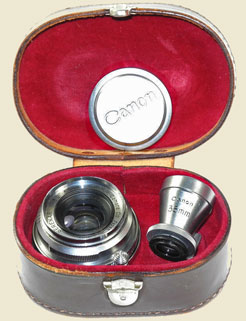
the Canon 35mm f3.2 lens of 1951 with accessory finder in a lined leather case
The Canon 35mm f3.2 continued to be produced until July 1952. During its three years of production, 7,719 lenses were sold. 2
Canon 35mm f2.8 Lens
In October 1951, Canon released one of its longest lived lens, the Canon 35mm f2.8. This lens was of 6 elements in 4 groups.
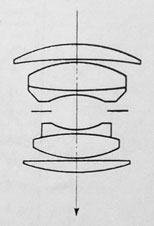
This lens competed directly with the Canon 35mm f3.2, but was the superior of the two. During its production until 1962, it underwent every important change Canon made to its range of lenses.
In 1951 and 1952, as a Serenar 35mm f2.8, it was released in a well constructed oval leather box
with the lens nestled next to a Canon 35mm finder.
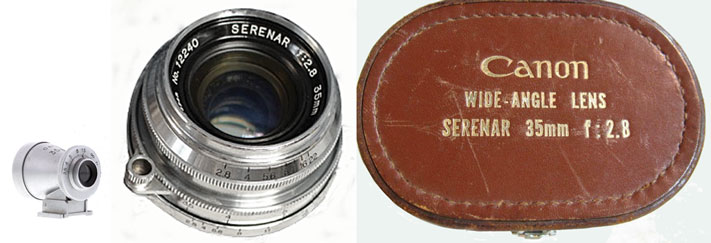
a Serenar 35mm f2.8 lens of 1952
Later, in January 1957, as part of the improved lens build of most of the Canon lens range, the Canon 35mm f2.8 was mounted in a light alloy body with black focusing ring.
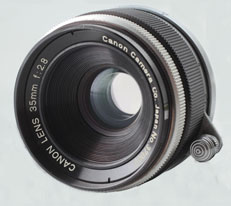
an improved Canon 35mm f2.8 lens in black finish of 1957
This 1957 version of the 35mm f2.8 was offered a more attractive lens hood than previously - a hood which could also be used on the contemporary Canon 50mm f1.8. During its 11 years of production, the Canon 35mm f2.8 lens in its several forms sold 31,797, even while competing with several othe Canon 35mm and other wide angle lenses.
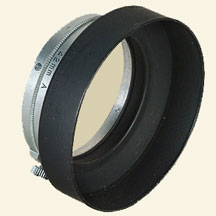
Canon hood for the 1957 35mm f2.8 and the Canon 50mm f1.8
Canon 35mm f1.8 Lens
In April 1956, Canon introduced a number of new lenses to coincide with the important launch of the Canon VT. The new Canon 35mm f1.8 was one of these, along with the updated Canon 50mm f1.8 in April 1956 and the new Canon 50mm f1.2 launched in September 1956. The 35mm F1.8 was of the new construction then being implemented by Canon, with a light-weight alloy body with satin chrome finish and a black aperture ring - a most attractive lens.
This is a 7 element in 4 groups design, and accepts a 40mm filter size.
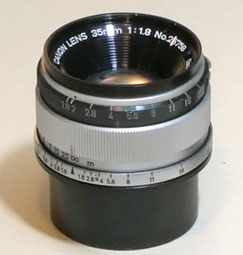
Canon 35mm f1.8 Lens of 1956
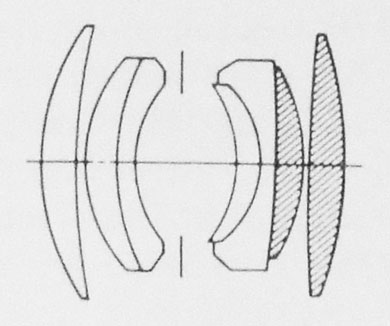
A Canon 35mm lens in 1956 was a good choice with the launch of the new Canon VT, since the camera had a brighter viewfinder with a choice between 50mm and 35mm viewfinder positions, without need of an accessory finder. Over the next 6 years, this lens sold 14,796 units even while competing with three other Canon 35mm lenses as well as 28mm and 25mm wide angle offerings.
Canon 35mm f2.0
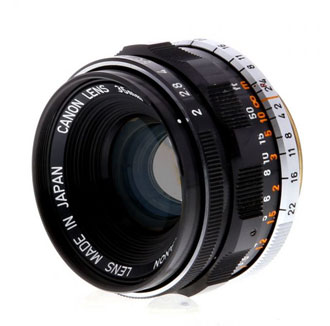
The final 35mm lens launched by Canon for its rangefinder cameras was and is often considered by photographers the best 35mm lens of the rangefinder era, and still sought out for use today. This is the Canon 35mm f2.0, launched in April 1962. The lens was a 7 element in 4 group design, accepting a 40mm filter.
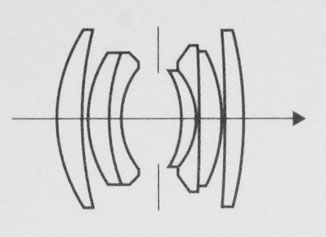
This lens is also one of Canon's most compact lenses as can be seen below, mounted on a matching black Canon P.
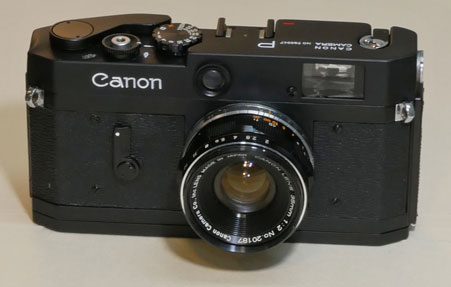
black Canon 35mm f2.0 lens of 1962 on a matching Canon P
Canon 35mm f1.5
In August 1958, Canon released a new 35mm f1.5 at the time of the release of the Canon VI-L and VI-T.
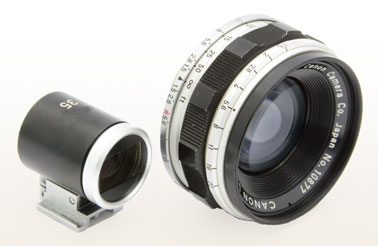
black Canon 35mm f1.5 lens of 1959 with finder
This was an 8 element in 4 groups design.
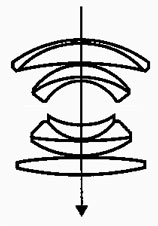
This was both a well-performing wide-angle and a popular one, continuing in production until March 1971. During these 13 years, it sold 5,173 units. 2
Canon and the 35mm lens
As can be seen from the descriptions above, and from the descriptions of the Canon rangefinder cameras from the 1956 Canon VT until the final Canon 7s, Canon consistantly did better in offering a 35mm viewfinder image, without accessories than did either Leica or Nikon. They matched their viewfinders with a series of fine 35mm focal length lenses. Some regard the 35mm lens as the more 'natural' than 50mm being closer to the breadth of vision of the human eye. They calculated that the theoretical focal length of a lens giving an image on a 35mm film size of 24mm X 36mm similar the the human eye is about 40mm - closer to the 35mm lens than the 50mm lens. Interestingly, the Leica CL/Minolta CLE were to feature 40mm as their standard focal length (two decades later).
You can click on the links in the table below to consult other pages of the canonrangfinder.org site.
| Navigation: Click Below to Jump to Desired Subject Page | ||
|---|---|---|
| Canon Rangefinder Cameras - 1 | Canon Rangefinder Cameras - 2 | Canon Rangefinder Lenses |
| Canon S | Canon IVSB2 | Canon 19mm |
| Canon J | Canon IIS2, IID2, IIF2 | Canon 25mm |
| Canon NS | Canon VT, Canon L2 | Canon 28mm |
| Canon JS | Canon L1, L3 | Canon 35mm |
| Canon J-II | Canon VT Deluxe | Nikkor 50mm |
| Canon S-II | Canon VL, VL2 | Canon 50mm |
| Canon IIB | Canon VI-L, VI-T | Canon 85mm |
| Canon III, IIC, IV | Canon P | Canon 100mm |
| Canon IIIA, IVF, IVS | Canon 7 | Canon 135mm |
| Canon IIA, IID, IID1 | Canon 7s | Canon 200mm-1000mm |
| Canon IVSB | Minolta Rangefinders | Minolta Lenses |
| Canon IIF, IIS | Other Rangefinders | other M39 lenses |
| Go to canonrangefinder.com home page | ||
Any additions or corrections to these pages would be welcome simply by contacting this site as shown at the foot of this page .
Footnotes:
1 Dechert, Peter. Canon Rangefinder Cameras 1933-1968. Hove Collectors Books. West Sussex, United Kingdom. 1985. ISBN 0-906447-30-5.
Peter Dechert's book is the most important expert source of information regarding Canon Rangefinder Cameras.
2 Kitchingman, Peter. Canon M39 Rangefinder Lenses 1939-1971. A Collector's Guide. Published by Peter Kitchingman. Perth, Australia. 2008. ISBN 978-0-646-48144-9.
Peter Kitchingman's book is the definitive study of the more than three decades of M39 format camera lenses developed for Canon Rangefinder Cameras.
3 Nostalgic Canon Camera Book. 懐かしいキヤノン EI Publishing Co. Ltd. Tokyo, Japan. June 2003.
Peter Kitchingman's book is the definitive study of the more than three decades of M39 format camera lenses developed for Canon Rangefinder Cameras.
4 "Canon Camera Museum" history website. https://global.canon/en/c-museum/history/ published by Canon, Inc. accessed in 2019.
5 Rajner, Hans P. (author), John Wade (editor). Leica Copies. Classic Collections Publications. London, UK. ISBN 13: 9781874485056
Hans P. Rajner's book is an excellently detailed and carefully researched study of camera from around the world which used the Leica M39 lens mount and the same lens to film plane distance.
7 Dechert, Peter. Canon Single Lens Reflex Cameras 1959-1991. Historical Camera Publications. Yakima, Washington. 1992. ISBN 1-879561-04-2.
8 Tomlinson, Shawn M. The Film Photography Book. Lulu Pulbications. 2016. ISBN: 9781365263972
9 Sartorius., Ghester. Identifying Leica Lenses. Classic Camera 19. Tokyo, Japan. 2001. ISBN 4-257-12029-0
10 website http://www.nicovandijk.net/rflensmatrix.htm consulted 2019.
11 O'Reagan, Douglas M. Allied Exploitation of German Science after World War II. Johns Hopkins University Press. Baltimore, Maryland. 2019. ISBN 9781421428888
12 website www.canonrangefinder.servehttp.com consulted 2008.
13 Minolta expert Andrea Aprà has posted information on minoltarangefinders group and other groups and further detailed information by email. (thanks Andrea !)
14 website http://www.collection-appareils.fr/objectifs/ consulted 2019.
15 Small, Marc James. Non-Leitz Leica Thread-Mount Lenses. Wittig Books. Hückelhoven, Germany. 1997. ISBN 3-930359-47-2.
16 the Nikon Corporation website: https://imaging.nikon.com/history/ consulted 2019.
17 p 152. Ray, Sidney F. Photographic Lens ISBN 9780240510323
18 website http://www.rokkorfiles.com/Lens%20History.html accessed 2019
If you have any comments or questions about this Canon Rangefinder site, please e-mail me (Larry Huffman) at e-mail address: [email protected]